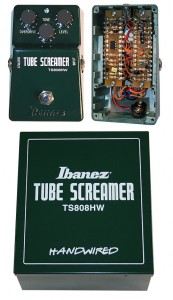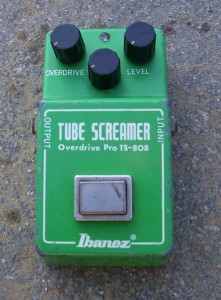We will begin this article with an honest question: Does the world need yet another Tube Screamer or Tube Screamer clone? The original pedal itself sees no end to its use and popularity, and from the 90’s onward there has been no stop in production from countless manufacturers, large and small, each creating their own stamp and version of the pedal based on the Tube Screamer circuit. From low-cost imports made in China that anyone can afford, to custom painted unique one-offs costing hundreds of dollars, there’s a Tube Screamer for every class and budget of musician. So don’t we have enough already?
With this well-saturated field, Ibanez now throws us a curve ball out to capture some of the boutique market for itself by creating an entirely unique Tube Screamer, the TS808HW. This is a model that is limited in production, and is completely hand-wired on turret boards and adds true bypass switching – a first for a production Ibanez Tube Screamer. Building it inside a new die-cast enclosure with angled contemporary design, the TS808HW  seems to merge the old-school technology with new-school looks. Packaged in a large green aluminum case, and with the TS808HW resting in the center of its foam insert, this is clearly a pedal that is aimed at collectors and Tube Screamer aficionados. Its price? It retails with a list of $499, but has an average street price of $349. The current TS808 reissue pedal streets for about $175 less than the TS808HW.
seems to merge the old-school technology with new-school looks. Packaged in a large green aluminum case, and with the TS808HW resting in the center of its foam insert, this is clearly a pedal that is aimed at collectors and Tube Screamer aficionados. Its price? It retails with a list of $499, but has an average street price of $349. The current TS808 reissue pedal streets for about $175 less than the TS808HW.
We plugged in the HW model alongside an off-the-shelf TS808 stock reissue first to compare the two. Using the same settings and going from lighter overdrive settings with the tone control rolled back, to more aggressive drive and tone control use, there were some immediate differences between the two units.
In fact, some of us were floored by how nice the TS808HW sounded. It seemed to allow quite a bit more of the bass frequencies to come through the mix. The overdrive, even when turned up, sounded smooth and full, and there was no brittleness evident unless we turned the tone control up well past 3 o’clock. Now THIS is a Tube Screamer, we thought to ourselves collectively. We even considered that there must have been some kind of circuit change, because surely a handwired pedal won’t make THAT much difference, could it? We’re talking a 9 volt driven effects box with a simple op-amp afterall, not a boutique tube amplifier running 100’s of volts from its transformer.
Something was different. The TS808 standard reissue was a bit dull on the lows and highs in comparison to the handwired model. Sure, it still sounded like a Tube Screamer; they both had the Tube Screamer character overall, but the TS808 standard reissue had a smaller midrange-focused feel at all settings. The lows were subdued and the highs were again, a bit dulled. Again, not a bad pedal, but a bit small and boxey when sitting next to the TS808HW, which is clearly a more dynamic box.
This A/B’ing began a quest for more information. What are the secrets of this TS808HW? Is this Ibanez’ attempt at making a modded Tube Screamer? Could they have taken some of Robert Keeley’s excellent mods – notably where he improves the low end response – and incorporated them into their own design? LegendaryTones site owner David Szabados was convinced that Ibanez did something unique to the circuit…He just wasn’t quite sure what.
And what about the “true” Tube Screamer sound? Certainly the standard reissue TS808 was closest to the original in terms of design, features, and looks. Would a genuine original TS808 sound more like the reissue, or the hand wired model?
In the meantime as we grew more excited about this Tube Screamer hand wired, David posted his initial thoughts in the Harmony-Central effects review page. All 10’s and happy as a clam and excited about this latest model.
A few weeks went by and our staffers began to wonder what other Tube Screamers could sound like if compared next to this one. Would the TS808HW remain the ultimate Tube Screamer? The TS808HW, like the standard reissue TS808, both use a reissue JRC4558D op-amp in the circuit. But Ibanez takes this a step further because they know that a chip is not “just a chip” – so they use only certain select JRC’s that exhibit characteristics closest to the early original JRC’s as used in the first Tube Screamers in the late 1970’s.
We needed to get an original TS808 into the mix and add it to the test. In addition to that and the reissue, which we already compared, we thought the Maxon OD808 would be good to bring back into the test. Why? Maxon is the original manufacturer of the Ibanez Tube Screamer, and it’s only over the course of the last five or six years that Ibanez has taken on the manufacturing itself. An original TS808 will have a Maxon board, and a Maxon OD808 will obviously have one as well. Would the Maxon-based products reveal some secret or commonalities that allude the Ibanez circuits?
The Test Begins
We ran the same 9v DC power supply on all units into a clean-set amp for regular, consistent results. Our objective was to pick up on the nuances of each Tube Screamer. Some may call this “splitting hairs”, since “a Tube Screamer is a Tube Screamer” to some, but not to us!
The Maxon OD808
The Maxon exhibited the strongest midrange throughout the testing and we noticed that for some reason, it had a bit more volume when otherwise set to equal settings of all the  other pedals. Drive characteristics remained smooth as expected from low to high gain.
other pedals. Drive characteristics remained smooth as expected from low to high gain.
Looking inside the OD808 (because we have to open up all these boxes and sneak a peak!), it uses a JRC4558D reissue chip, though we do not know if it is from a special selected batch as the chips Ibanez uses for its reissue TS808 (Ibanez marks theirs with white paint). In any event, the OD808 is a satisfactory and lively pedal that will benefit systems where a mid punch is needed to cut solos through the mix.
The Ibanez TS808 Reissue
On its own, the TS808 reissue is a fine-sounding Tube Screamer. It’s able to provide nice warm breakup suitable for a range of styles of playing. It’s unfortunate that it went head to  head against the new TS808HW, because the HW is clearly a step above in terms of making the sound and feel of the guitar’s audio spectrum “bigger,” with most of the emphasis and warmth on the HW version emphasized on the lows. The overdrive of the HW sounds different as a result.
head against the new TS808HW, because the HW is clearly a step above in terms of making the sound and feel of the guitar’s audio spectrum “bigger,” with most of the emphasis and warmth on the HW version emphasized on the lows. The overdrive of the HW sounds different as a result.
As explained earlier, the standard reissue could be characterized as slightly duller on the lows and highs when compared to HW unit. Its midrange character falls somewhere between the OD808 and the HW, filling a comfortable middle ground.
The Mystery of the TS808HW?
We opened up the HW unit and I also asked Jacob Adams, Vice President of Keeley Electronics, what he thought of the HW circuit. Jacob felt nearly certain that the circuit itself was stock original, but made note that Ibanez chose to deploy ½ watt resistors. This shouldn’t technically make a difference, as tone is altered by the value of the resistor, and not its wattage capacity.
We asked Jacob about the possibility of capacitance of the standard RI’s circuit board perhaps contributing to the handwired’s warmer tone and he agreed that there may be some of this effect coming into play. The idea is basically this: As circuit board traces are layed out in design, those traces themselves collectively can serve as a capacitor, and the net sonic effect would be a brightening effect caused by the traces. This idea of capacitance is more clear cut on amplifier circuits which run high voltages however, and isn’t supposed to be an issue with low-voltage electronics. So the effect on a 9v-operated pedal should be negligible. But still, this indeed could help explain why the HW model, which uses no circuit board comes out as a slightly darker and warmer Tube Screamer than the stock Ibanez TS808 reissue..
Comparison with an original Ibanez TS808 from 1980
Original TS808’s go for big money and many of us always assumed that this was more about collectors pushing the market rather than tone. But the test wouldn’t be complete without sourcing an original TS808 however, so we located a unit with a JRC4558D chip that was date coded from 1980. All board components were original and the unit functioned without any noise or problems.
The result of the tone test? Surprisingly, we discovered that there was indeed some mojo found in the original tube screamer. In a similar fashion to the HW model, it allowed a good deal of low-end transparency, and in fact, felt a little bit less compressed than the HW unit on the lows.
Where the original model differs from any of the other Tube Screamers compared, was with its sustain and top end response. The original TS exhibited an ear-pleasing,  non-brittle presence and bite that quite frankly the other TS units lacked. The overdrive’s sustain and tone were also judged stronger as notes clearly sang longer on leads. Between our test staffers, the original TS808 was the clear favorite, with the HW coming in second, followed by the Maxon OD808 and Ibanez TS808 reissue splitting the vote for third.
non-brittle presence and bite that quite frankly the other TS units lacked. The overdrive’s sustain and tone were also judged stronger as notes clearly sang longer on leads. Between our test staffers, the original TS808 was the clear favorite, with the HW coming in second, followed by the Maxon OD808 and Ibanez TS808 reissue splitting the vote for third.
With the surprise finish of the original TS808, we knew that our testing and experimentation would have to continue. Frankly, we were interested in finding out if we could discover what it was specifically that made the original TS808 such a tonal treat to our ears. Was it the use of the original JRC op-amp? Or perhaps the clipping diodes or some other components were made differently in this original 808 than what’s available and used today in other tube screamers? Perhaps it was simply a lucky shift and the tolerances for the original components drifted and created these favorable tones? Whatever differences exist, we were certain to get to the bottom of this new mystery. Our next project: Can we take the Ibanez TS808 standard reissue and duplicate the tone of the original by changing key components on the board? Stay tuned to find out our results.